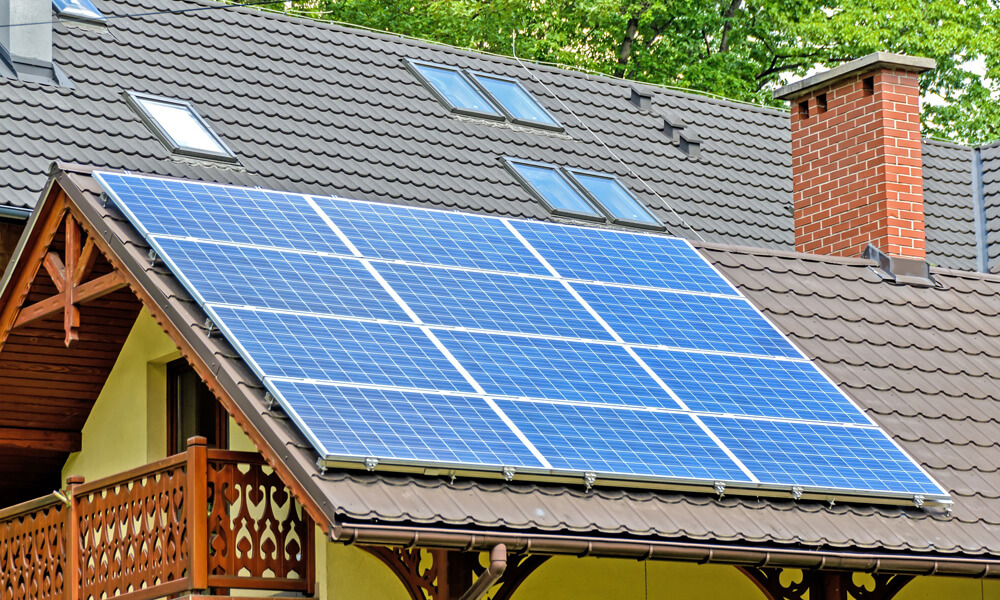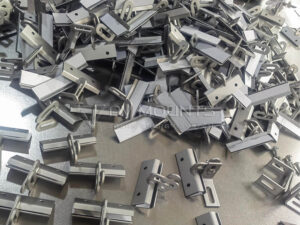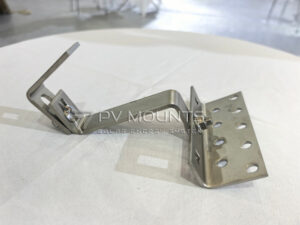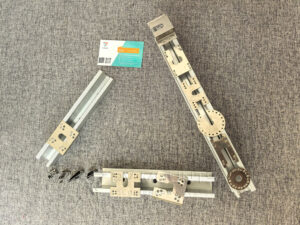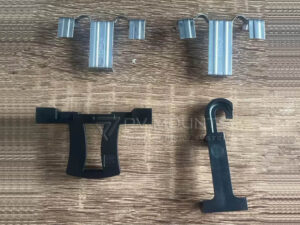Solar energy has brought innovations, including roof mounting systems for solar panels available to home and business owners. Choosing the right solar panel roof mounting systems is crucial for the effectiveness and durability of a solar power setup. Let’s explore the different types of solar panel roof mounts. We want to help you find the best option that not only looks good but also functions well. Consider the different choices and how they balance aesthetics with functionality.
Table of Contents
1. Fixed Mounts
Stability Meets Simplicity
At the heart of solar panel installation lies the fixed mount system, revered for its straightforward design and reliability. This mount is designed to provide a stable base for solar panels at a specific angle for optimal sunlight exposure. It is fixed in place and ensures that the panels remain stable. Fixed mounts are cost-effective and easy to install, making them a great option for those new to solar energy.
However, the simplicity of fixed mounts comes with its limitations. Adjustable solar systems can’t adapt to seasonal variations in sun position, leading to suboptimal energy production during certain times. Prospective users must weigh these considerations, balancing the immediate benefits of lower costs and more straightforward setup against the long-term efficiency of their solar array.
2. Adjustable Mounts
Flexibility for Maximum Efficiency
The world of solar doesn’t stand still, nor do the sun’s rays. Enter adjustable mounts, the chameleons of the solar mounting world. These systems can adjust tilt angles based on the seasonal arc of the sun, unlike fixed counterparts. This adaptability ensures that solar panels can maintain an optimal angle to the sun year-round, maximizing energy absorption and efficiency.
The beauty of adjustable mounts lies in their versatility. Adjusting the solar panel’s orientation can enhance energy production, even during less sunny seasons. However, this flexibility comes at a cost, both financially and in terms of installation complexity. Higher initial expenses and potential maintenance considerations make adjustable mounts a more sophisticated choice suited for those willing to invest in long-term gains.
Despite these challenges, the allure of adjustable mounts is undeniable. They represent a middle ground between the simplicity of fixed systems and the high-tech appeal of tracking mounts. For those seeking to squeeze every drop of power from their solar investment, adjustable mounts offer a compelling solution.
3. Tracking Mounts
Following the Sun: The Dynamic Solution
In the quest for peak solar efficiency, tracking mounts stand out as the pinnacle of innovation. These systems take adaptability to the next level by actively following the sun’s path across the sky. Available in single-axis and dual-axis configurations, tracking mounts adjust both horizontally and vertically, ensuring solar panels face the sun at the ideal angle throughout the day.
Tracking mounts optimize panels’ orientation throughout the day, capturing more sunlight than static systems. This increased exposure can lead to substantial gains in energy production, making tracking mounts especially appealing for locations with less direct sunlight.
However, the sophistication of tracking systems introduces complexity and cost. Their moving parts require more maintenance, and the initial setup is more involved, translating to higher upfront costs. Furthermore, their advanced technology makes them a more suitable option for commercial installations or residential users with specific energy needs and a higher budget.
4. Ballasted Mounting Systems
Weight-Based Solutions for Flat Roofs
Ballasted mounting systems stand as a beacon of innovation for solar installations on flat roofs. These systems rely on the strategic use of weight to anchor solar panels in place, eschewing the need for penetrative mounting methods. The essence of ballasted mounts lies in their simplicity and non-invasiveness, making them especially suitable for flat-roofed structures where roof integrity is paramount.
Pros: The primary advantage of ballasted systems is their minimal roof penetration. By using weights to secure solar panels, these mounts significantly reduce the risk of leaks and structural damage, a common concern with direct attachment methods. This approach preserves the roof’s integrity while providing a reliable platform for solar installations.
Cons: However, the reliance on weight for stability introduces limitations and challenges. The substantial mass required to anchor the panels can strain roof structures not designed to bear additional loads. Furthermore, in areas prone to high winds, there’s an increased risk of wind uplift, which could compromise the system’s stability and safety. These factors necessitate careful weight management and engineering assessments to ensure the roof can support the additional load without compromising the system’s security.
5. Roof Integrated Mounting
Seamless Solar Integration
Roof-integrated mounting systems represent the pinnacle of aesthetic solar solutions, blending functionality with a sleek design. Unlike traditional mounts that sit atop the roofing material, integrated systems are designed to be part of the roof itself, offering a seamless appearance. This integration not only enhances the visual appeal of solar installations but also provides a level of protection and durability akin to traditional roofing materials.
Aesthetics and Integration Benefits: The allure of roof-integrated systems lies in their ability to maintain the aesthetic integrity of the building. By integrating solar panels directly into the roofing surface, these systems offer a more cohesive and attractive alternative to conventional raised mounts, appealing to property owners concerned with preserving architectural aesthetics.
Performance Comparison: In terms of performance, roof-integrated systems can match or surpass that of standard mounts, although the specifics may vary based on installation and environmental factors. The proximity to the roof can impact cooling efficiency, potentially affecting performance during peak sun exposure. However, advances in design and materials continue to mitigate these concerns, making roof-integrated solar a viable and efficient option.
Installation Specifics and Ideal Scenarios for Use: Installation of roof-integrated solar systems requires precise planning and execution, often involving the replacement of existing roofing materials with solar-integrated panels. This process makes them particularly suitable for new constructions or renovations where the roof is being replaced. The ideal scenario for their use is in residential or commercial properties where aesthetic considerations are paramount and the roof structure is being updated or newly constructed.
6. Ground-Mounted Systems
Beyond the Roof: Expanding Possibilities
Not all solar journeys start on the roof. For those with the luxury of space, ground-mounted systems offer a versatile alternative. These installations are particularly advantageous when roofing constraints, such as space, orientation, or structural limitations, make rooftop mounting impractical.
Ground-mounted systems excel in scalability and adjustability. They can be installed at the perfect angle and orientation, unbound by the constraints of roof architecture. This freedom allows for optimized solar panel performance and easier maintenance access. Moreover, ground mounts can be a preferable choice for homes in snowy regions, where roof access for clearing snow from panels can be challenging.
The primary considerations for ground-mounted solar include land usage and installation costs. These systems require suitable land that is not shaded and is appropriately zoned for solar installation. Additionally, the need for concrete foundations and longer cable runs can increase installation costs compared to rooftop systems.
7. Specialty Mounts
Innovative Solutions for Unique Challenges
The realm of solar installations is not limited to the conventional; it thrives on innovation, mainly through specialty mounts. These unique configurations, such as pole mounts and carport mounts, serve as a testament to the versatility and adaptability of solar technology. Specialty mounts offer bespoke solutions that cater to specific site conditions, aesthetic preferences, or functional requirements that standard mounts cannot address.
Pole Mounts: These mounts elevate solar panels above the ground on single or multiple poles, making them ideal for locations with limited space or uneven terrain. Pole mounts can also be adjusted for angle and orientation, enhancing their efficiency. They’re particularly beneficial in areas where elevated positioning can lead to better sun exposure and, consequently, higher energy production.
Carport Mounts: Solar carports transform ordinary parking spaces into power-producing areas, providing dual functionality. Not only do they offer covered parking, but they also harness solar energy, making them a smart choice for both residential and commercial properties looking to maximize unused open areas.
The innovation behind specialty mounts does more than expand the physical possibilities for solar panel installation; it makes solar energy accessible and applicable in diverse settings. By tailoring solutions to meet specific challenges, specialty mounts push the boundaries of what’s possible in solar energy deployment.
8. Choosing the Right System
Matching Mounts to Needs: A Decision-Making Guide
Selecting the appropriate solar panel roof mounting system is a decision that shouldn’t be taken lightly. It requires a comprehensive evaluation of various factors to ensure that the chosen system aligns with your energy goals, site conditions, and budget. Here are some critical considerations:
Site Conditions
Evaluate the physical attributes of your installation site. Factors such as roof slope, strength, orientation, and available space play a pivotal role in determining the most suitable mounting system.
Energy Requirements
Your energy consumption patterns and goals should guide your choice of mounting system. High-efficiency systems like tracking mounts may be preferable for higher energy needs, while fixed mounts suffice for modest requirements.
Aesthetic Preferences
For many property owners, the visual impact of solar panels is a significant consideration. Roof-integrated systems offer a seamless look, whereas other mounts may provide a more industrial appearance.
Local Regulations and Incentives
Understanding local building codes, zoning laws, and available solar incentives can influence your mounting system choice. Compliance with regulations and maximization of incentives can significantly impact the project’s feasibility and return on investment.
Professional Assessments
Engaging with solar energy professionals for site assessments and system recommendations is crucial. Their expertise can help navigate the complexities of system selection, ensuring that all technical, regulatory, and financial aspects are considered.
Long-term Implications
Consider the durability, maintenance requirements, and potential for future system expansion. The right system should not only meet your current needs but also accommodate future solar ambitions.
The decision-making process for selecting a solar panel roof mounting system is intricate, requiring a balance between technical specifications, financial considerations, and personal preferences. By carefully assessing these factors, property owners can make informed decisions, ensuring their solar installations are optimized for performance, compliant with regulations, and aligned with their long-term energy goals.
9. Conclusion
Choosing the right solar panel mounting system is crucial for the efficiency, cost, and durability of your project. From fixed mounts to tracking systems and ground-mounted solutions, there’s an option for every need. Expert advice can help you select the ideal system for a sustainable and energy-independent future.


